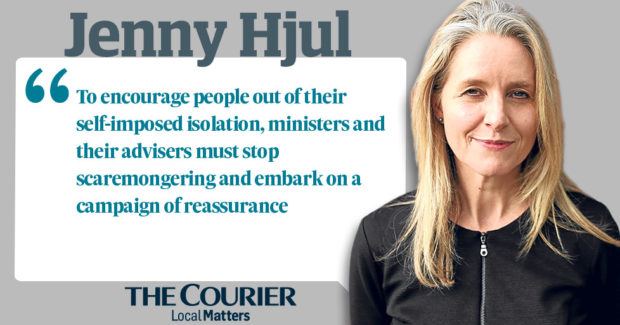The most sense spoken in recent days about our post Covid future has come from two business leaders, both women as it happens.
About a week ago, the finance supremo (and mother of nine) Helena Morrissey wrote about the deserted streets and offices in the City of London, warning that the economy could not recover while people stayed at home.
Then the chief executive of the Scottish Chamber of Commerce, Liz Cameron, issued her own alarm bells in the wake of retail doom and gloom.
‘For those sectors which remain closed or have just resumed operations recently, helping them back to work and restoring consumer confidence as quickly as possible is crucial to their immediate survival,’ said Dr Cameron.
Her comments follow a new survey of Chamber members that showed 63 per cent of firms reported poor customer demand.
This is not at all surprising. Despite the gradual easing of lockdown, life has not regained any semblance of normality anywhere in the UK.
Morrissey noted that in the week Britain was supposed to return to work, just a third of British office workers were back at their desks, compared with 83 per cent of those in France and 76 per cent in Italy.
The consequences of our new stay at home culture are dire, said Morrisey: ‘The abandonment of the traditional workplace is causing real damage, particularly to the huge sector — often small, independent businesses — that is dependent on thriving office life, including cafes, sandwich shops, bars, newsagents and taxi drivers.’
I thought that people would be raring to reclaim what they lost in the coronavirus lockdown and that life as we knew it would soon be back on track.
But there has been an astonishing reluctance by much of the population to escape the restrictions imposed during the pandemic.
Those of us who gleefully jump on trains to London or venture abroad at the first chance are regarded as reckless by friends and neighbours, as if we are asking for trouble.
But it is they who are acting dangerously, egged on by governments, on both sides of the border, who have made an excellent job of creating a new epidemic of anxiety.
The Treasury has kept Covid Britain (and that includes Scotland) afloat with £30 billion through its furlough scheme, but this level of support is unsustainable.
To avoid economic armageddon, people have to go back to work – to their offices – and do their bit for the country, beyond shopping online.
To encourage them out of their self-imposed isolation, ministers and their advisers must stop scaremongering and embark on a campaign of reassurance.
There should be an end to sudden quarantines so that travel routes can reopen and tourists can board planes with confidence.
The scramble by Brits to get back from France was farcical. Despite a rise in infections in a few pockets of that country, there have been very few hospital admissions and many of the new cases are among younger people who tend not to have symptoms.
In Scotland, more than a month has now passed since any fatalities were recorded among those testing positive yet our top officials are continuing to spread fear.
Devi Sridhar, who advises the Scottish government on the virus, has warned that Scotland is ‘facing a stream of infection from England and Wales’ and complains that we can’t shut the borders because we are part of the United Kingdom.
There have been outbreaks of coronavirus in Scotland too – in Aberdeen and Orkney – making border closures futile. But that’s not the point.
The ‘serious resurgence’ Sridhar predicts is careless talk from someone who should know better. Unless she has a political agenda, like the government she serves, in driving xenophobia among Scots, what is the purpose of bigging up the pandemic now when the smart science suggests it is in retreat?
Current mortality rates in Britain are believed to be less than 0.5 per cent and much lower among the under-70s. Most of us are more likely to die in road accidents than from Covid-19, according to statisticians.
We should be much more worried about cancer care, in fact, with Britain bottom of an international league in survival rates and specialists saying thousands of patients could die early because of delayed referrals during the lockdown.
It is time to put the pandemic in perspective. Government must take the lead – opening mothballed Whitehall departments and insisting civil servants turn up at their workplaces – with the private sector (the flashy financial houses too) following suit.
Then the rest of us of able body and mind must stop making excuses, acknowledge that life comes with some risk, and that it is the responsibility of everyone – not just the NHS, public transport workers, delivery drivers and supermarket staff – to put Britain (Scotland included) back on its feet.


